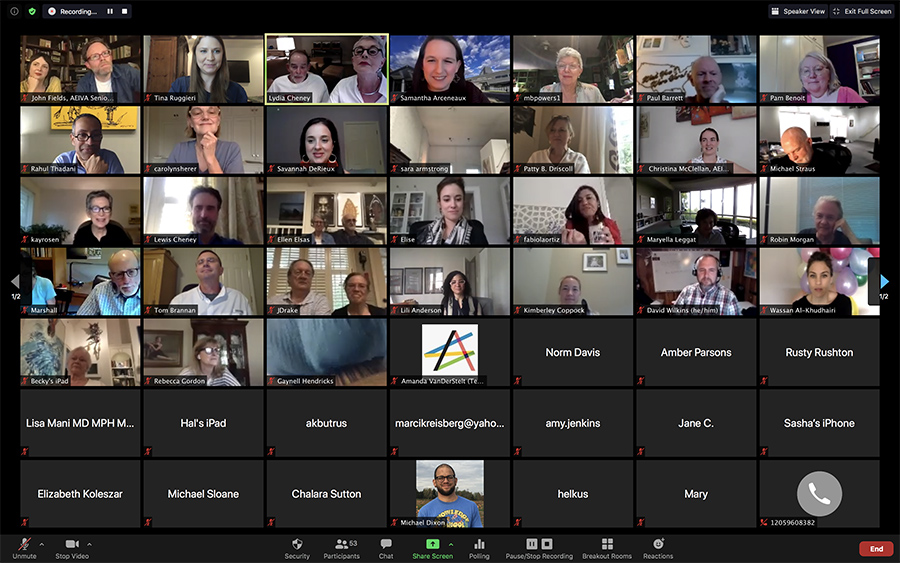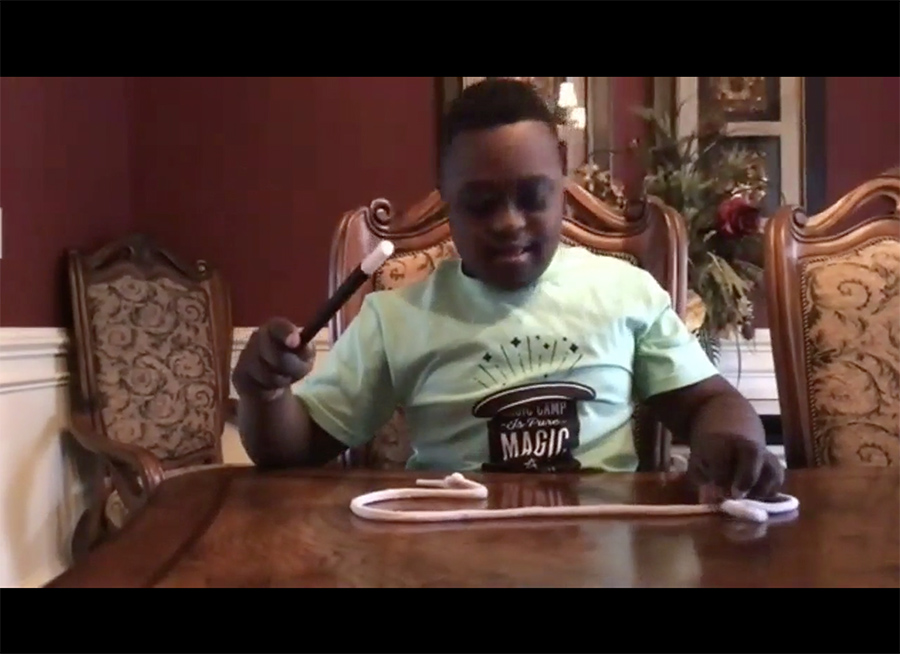 The Birmingham Arts Drive-in was a two-night, sold-out event featuring performances from five of the city's most beloved arts organizations.The pandemic may have paused attendance in person, but it has not stopped the need for arts education and performances in our lives.
The Birmingham Arts Drive-in was a two-night, sold-out event featuring performances from five of the city's most beloved arts organizations.The pandemic may have paused attendance in person, but it has not stopped the need for arts education and performances in our lives.
Arts organizations at the University of Alabama at Birmingham are pioneering new ways to provide enriching arts experiences while taking measures to stop the spread of COVID-19. Their goal is to give audiences new ways to enjoy the arts, from physically distanced and streamed live performances to community classes, meet-the-artist gallery talks and more.
UAB’s Alys Stephens Performing Arts Center, Abroms-Engel Institute for the Visual Arts, ArtPlay and Institute for Arts in Medicine quickly shifted their programming to a virtual world. And while these centers and programs are holding fast to the artists and audiences that drive their missions, they are also catching the interests of a global audience — attracting viewers from as far as Europe, Australia, Brazil and Korea. With none of the usual geographic limitations of live performance, people from around the world with access to the internet can watch from wherever they are.
Audiences can explore their archive of activities, including artist-led crafts, art lessons, art discussions, story time and movement sessions, and even some en Español, on demand at www.alysstephens.org/arts-on-demand.
New performances for the fall will be announced in September, including the Alys Stephens Center’s new season, ArtPlay’s fall arts classes for all ages, Arts in Medicine’s virtual Mental Health Mondays and AEIVA’s upcoming “A la Carte” exhibition. Patrons of the Arts Circle Club get even more access to the arts, including the chance to talk with artists about their work, among other opportunities.
 An Arts Circle Live event. Patrons of the Arts Circle Club get even more access to the arts, including the chance to talk with artists about their work, among other opportunities.Alys Stephens Center
An Arts Circle Live event. Patrons of the Arts Circle Club get even more access to the arts, including the chance to talk with artists about their work, among other opportunities.Alys Stephens Center
In July, the Alys Stephens Center partnered with the city’s favorite arts organizations for the free, sold-out and livestreamed Birmingham Arts Drive-in. Over two nights, performances from the Alabama Ballet, Alabama Symphony Orchestra, Opera Birmingham and Red Mountain Theatre Company, filmed inside the center’s halls, were debuted live on a big screen in a lot on the UAB campus. The performances were also streamed by community partner Avondale Brewing and on the ASC YouTube channel and Facebook page, by nearly 6,000 people across the country and in Korea, India, Colombia and Germany. Alys Stephens Center has hosted artist meet-and-greets and performances with artists Delfeayo Marsalis and Sheléa Frazier and free, professional workshops for teachers.
AEIVA
AEIVA’s free virtual activities with guest artists have drawn audiences from Canada, the United Kingdom, Netherlands, Switzerland, Germany, Bulgaria, France, Italy and more. Sessions with artists Jon Key, Michael Dixon, Shona McAndrew, Thaddeus Mosley, Austyn Weiner, Paul Rusconi and more can be found on its YouTube playlist channel, including:
- Inside the Arts Live gallery talks
- AEIVA Face to Face interviews
- Outside the Lines Live coloring nights; upcoming events are 3, Oct. 1, Nov. 5, Dec. 3 and Dec. 17
- AEIVA Behind the Scenes series
AEIVA also collaborated with the School of Medicine and the Birmingham Civil Rights Institute for an innovative, “first-of-its-kind” course that uses art to help medical students hone their observational skills in order to make more accurate diagnoses. “Prescribing Art: How Observation Enhances Medicine” was presented the last week of April in response to the pandemic.
Using works of art, “Prescribing Art” helps medical students improve observational skills across three domains: in clinical encounters, in their perceptions of biases, and in their tolerance of ambiguity or uncertainty. Each of these domains is a fundamental skill to learn, and each is challenged by the distancing of COVID-19, says Stephen Russell, M.D., special topics course coordinator and associate professor of internal medicine and pediatrics. A story by ArtNet attracted even more interest, with students from India and students and educators in other states looking for more information.
“Our program teaches the importance of asking questions to correctly diagnose and treat disorders and not jump to medical conclusions based on how a person presents themselves,” Russell told Healio Primary Care. “By using art as a medium to examine bias, the students learned something new about themselves and each other.”
 ArtPlay's musical theater camp.ArtPlay and the Institute for Arts in Medicine
ArtPlay's musical theater camp.ArtPlay and the Institute for Arts in Medicine
ArtPlay and the Institute for Arts in Medicine conducted summer camps via Zoom: visual arts and musical theater camps, and magic camps for children with disabilities, respectively.
ArtPlay’s virtual camps and classes this summer reached more than 100 participants, with students from Ohio, New Jersey and Texas, and as far as Bogotá, Colombia. Once a month, ArtPlay also gives families adventures in science and art with Vocabby’s World, a community vocabulary program, for ages birth to 5 years and their guardians. Each month, students learn new words and explore arts-integrated lessons with the help of the lovable Vocabby.
Due to the success of its summer camp offerings, ArtPlay hosted teachers and organizations to learn best practices for virtual engagement through its Virtual Engagement Workshop. Teachers from Hawaii, Colorado, New York, Florida and others joined Alabama teachers to learn best practices for teaching online. This success led ArtPlay to schedule other workshops for teachers in September.
Starting in October, ArtPlay will host its vast array of community classes online for both children and adults, as well as learning opportunities for schools and community participants through its school-based programming and virtual lunch-and-learn events. For families, ArtPlay will host two virtual holiday events for Halloween and the winter holiday season.
AIM, a partnership between UAB Medicine and the Alys Stephens Center, focuses on the healing of the whole person — mind, body and spirit — with both interactive and passive arts experiences, which can include bedside and workshop activities or performances and visual art installations in public spaces. Research suggests engaging in the arts can aid in the prevention, treatment and management of physical and mental health conditions that may arise throughout the lifespan. An integral part of AIM’s mission is in-person visits that provide opportunities for social connection. However, videos and virtual platforms have enabled AIM to engage with more than 26,000 people since March.
The UAB Magic Camp is a collaboration between AIM and the UAB School of Health Professions’ Department of Occupational Therapy, Hocus Focus™ and Children’s of Alabama.
 Camper Joshua performs a magic trick during the Arts in Medicine virtual Magic Camp.Learning and performing magic tricks has been shown to benefit children and adults with disabilities. The approach has shown to be an effective treatment technique as it promotes motivation and improves physical, psychological, perceptual or social functions in those who participate.
Camper Joshua performs a magic trick during the Arts in Medicine virtual Magic Camp.Learning and performing magic tricks has been shown to benefit children and adults with disabilities. The approach has shown to be an effective treatment technique as it promotes motivation and improves physical, psychological, perceptual or social functions in those who participate.
This summer, nearly 50 children were able to join the virtual Magic Camp: 21 from the Greater Birmingham area, 16 from elsewhere in Alabama and 12 children from other states, as far as California and Minnesota — something that would not have been possible had the camp not been virtual. Lauren Edwards, camp administrator, was delighted to see the campers create friendships that have continued after camp. Additionally, “we saw camera-shy kids blossom into creative magicians excited to share their new skills for friends and family.”
Virtual Mental Health Mondays are monthly events during which AIM explores issues that impact mental health through the lens of arts and creativity. Past programs explored the intersections of cultural arts and racial healing, and spirituality and creativity.
AIM also continues its mission by creating arts and wellness videos, conducting live Zoom events with patients and community members, and by providing packaged art kits by request for patients to work on at home or in the hospital. Connecting with patients via Zoom workshops has been an effective alternative during a time when in-person visits has been significantly reduced.
AIM artists-in-residence Salaam Green, Valerie Hanks and Elizabeth Vander Kamp all agree that virtual meetings have allowed them to have meaningful connections with both adults and adolescents in treatment for cancer. Participants have the opportunity to express themselves creatively via journaling, storytelling and artmaking. Additionally, the virtual workshops provide the patients with a space for social connection even if they may be miles apart.